writing 1.2 completeness
英语写作教程第七讲
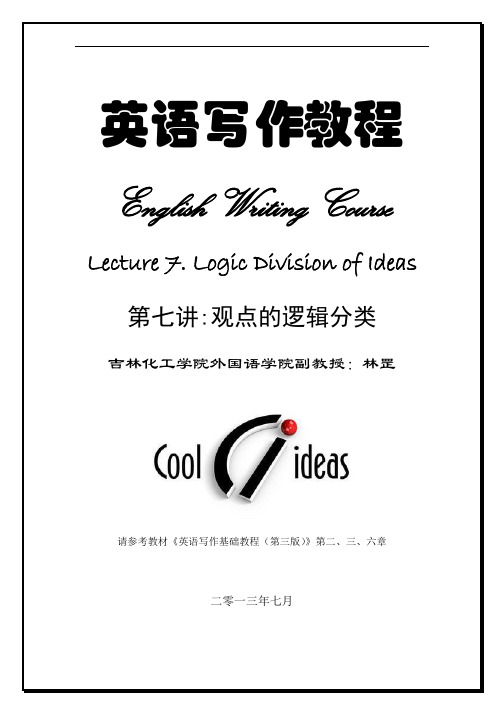
英语写作教程 English Writing Course Lecture 7. Logic Division of Ideas 第七讲:观点的逻辑分类 吉林化工学院外国语学院副教授:林罡请参考教材《英语写作基础教程(第三版)》第二、三、六章二零一三年七月Lecture 7 Logic Division of Ideas (1)Prewriting: Group Ideas Logically (1)Essay Model: Logical Division of Ideas (3)Part I. Organisation: Logical Division of Ideas (5)Developing a Logical Division Topic (5)Using examples to support (6)Practice: Examples (7)Introducing Examples (8)Practice: Developing Logical Division Paragraphs (9)Writing Assignment: Logical Division of Ideas Group Essay (10)Part II. Grammar and Mechanics (11)Model Essay: Appositives and Adjective Clauses (11)Restrictive and Non-restrictive Appositives (13)Practice: Commas with Restrictive and Non-restrictive Appositives (14)Restrictive and Nonrestrictive Adjective Clauses (16)Practice: Commas with Restrictive and Non-restrictive Adjective Clauses (16)Practice: Commas / Capitalisation Review (17)Part III. Sentence Structures: Complex Sentences with Adjective Clauses (18)Subject Pattern Adjective Clauses (19)Practice: Subject Pattern Adjective Clauses (20)Object Pattern Adjective Clauses (21)Practice: Object Pattern Adjective Clauses (22)Practice: Adjective Clause (22)Writing Assignment: Sentence Combining (23)Part IV The Writing Portfolio (25)Step 1. Prewrite to get ideas (25)Step 2. Organise the idea. (25)Step 3. Write the Rough Draft (25)Step 4. Edit the Rough Draft. (25)STEP 5. Write the Second Draft (27)STEP 6. Write the Final Draft. (27)Part V. Vocabulary to Enhance your Writing (28)Lecture 7 Logic Division of IdeasIn this lecture, you will expand your knowledge of essay writing. You will learn how to organise a large, complex topic by grouping ideas together and discussing each group in a separate paragraph. This method of organisation, called logical division of ideas, is useful for many kinds for writing, from business letter and memos to college essays and research papers.Prewriting: Group Ideas LogicallyB. Divide the list of sports on the workbook. There is more than one possible way to divide the list. First, decide what your categories will be and label the chart. You may have more or fewer categories than there are columns in the chart. If you need more columns or more space in each column, add them.Essay Model: Logical Division of IdeasPart I. Organisation: Logical Division of IdeasWhen you write an essay, you must divide your topic into paragraphs. One method of dividing a topic is to use time order. Another method of dividing the topic might be to write about the various causes of the event. To do this, you would group them into social, political, and economic causes and write about each group separately.Dividing a topic by grouping ideas that have something in common is called logical division of ideas. You can organise the information on many topics by this method. For example, you can divide the topic of sports into individual sports and team sports, or summer, winter, and year-round sports, or sports played with a ball, and sports played without a ball, and so on.Developing a Logical Division TopicUsing examples to supportPractice: ExamplesIntroducing ExamplesPractice: Developing Logical Division ParagraphsWriting Assignment: Logical Division of Ideas Group Essay Work with a group of four to six students and write a four or five-paragraph logical division essay on the topic “kinds of Good Lies”. A different student will write each paragraph, and one student will prepare the outline.1.Discuss as a group ways to write a funnel introduction. After your discussion, assignone person to write the introductory paragraph.2.Discuss as a group ways to write a concluding paragraph. Assign one person to writethe conclusion.3.Assign a different student to write each body paragraph.4.Assign one student to write a detailed outline.5.After you have completed your rough drafts, edit and revise each paragraph in yourgroup. Exchange papers and check each other’s work. Check each body paragraph especially for adequate supporting examples. Make any necessary corrections or revisions. Then combine your paragraphs into one essay (type in Document Format) and check it for completeness and coherence. Refer to the Editing Checklist. Finally, check the outline and clip it to the essay before handing it in.Part II. Grammar and MechanicsModel Essay: Appositives and Adjective ClausesAs you read the model essay, look for sentences that contain the words who, which, in which, on which and that. Underline the clauses that begin with these words.Restrictive and Non-restrictive AppositivesPractice: Commas with Restrictive and Non-restrictive Appositives Underline the appositive in each of the following sentences. Then decide whether it is necessary or unnecessary and write necessary or unnecessary in the parentheses following each sentence. Finally, add commas to separate an unnecessary appositive from the rest of the sentence.Write pairs of sentences containing appositive on your own. In one sentence, make the appositive unnecessary (non-restrictive). In the other sentence, make it necessary (restrictive). Underline the appositives and add commas if necessary. You may write about holidays in your country or about any other topic.Restrictive and Nonrestrictive Adjective ClausesPractice: Commas with Restrictive and Non-restrictive AdjectiveClausesPractice: Commas / Capitalisation ReviewPart III. Sentence Structures: Complex Sentences with Adjective ClausesSubject Pattern Adjective ClausesPractice: Subject Pattern Adjective ClausesObject Pattern Adjective ClausesPractice: Object Pattern Adjective ClausesPractice: Adjective ClauseWriting Assignment: Sentence CombiningPart IV The Writing PortfolioNow let’s complete the writing process you began at the beginning of this lecture. Write an essay discussing different types of television programs that students in your class watch. Follow these steps in order to write a good essay.Step 1. Prewrite to get ideasThis is the step you completed at the beginning of the lecture.Step 2. Organise the idea.Step 3. Write the Rough DraftStep 4. Edit the Rough Draft.STEP 5. Write the Second DraftWrite SECOND DRAFT at the top of your WWJ (Weekly Writing Journal). Write the second draft of your composition. Then ask your partner to proofreading.STEP 6. Write the Final Draft.After your partner returns your composition, write a neat final copy to hand in for final evaluation. Write Final Draft at the top of your paper.Part V. Vocabulary to Enhance your WritingUsing your English-English dictionary to study the following pairs of words, and then write out the difference.ANSWERS FOR LAST WEEK’S VOCABULARY STUDIES。
Teaching Writing Skills
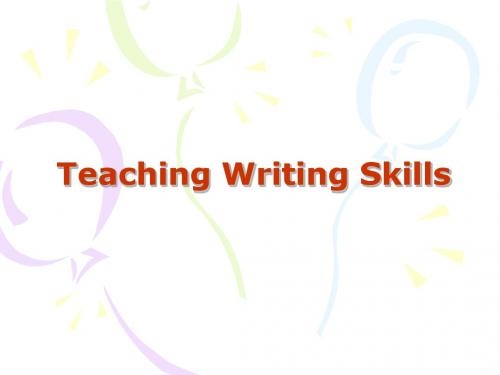
features of the product-oriented approach:
1. Compositions are supposed to meet certain standards of prescribed English rhetorical style, to reflect accurate grammar, and to be organized in conformity with what the reader would consider to be conventional; 2. The mechanics of writing are taught: handwriting, capitalization, punctuation, and spelling; 3. Students spend much time studying model texts provided by the teacher. Their attention is directed to the features of texts and teachers are mainly concerned with developing students’ ability to produce those features accurately; 4. The methodology involved analysis of model texts to make students be aware of the usage of grammatical structures and word choice in the texts; 5. The teacher’s role is to analyze the model text, to provide writing assignment as homework and to evaluate students’ product; 6. Class activities center on teacher’s explanation of the model text and students’ imitating, copying and transforming the model text;
英语写作基本要求
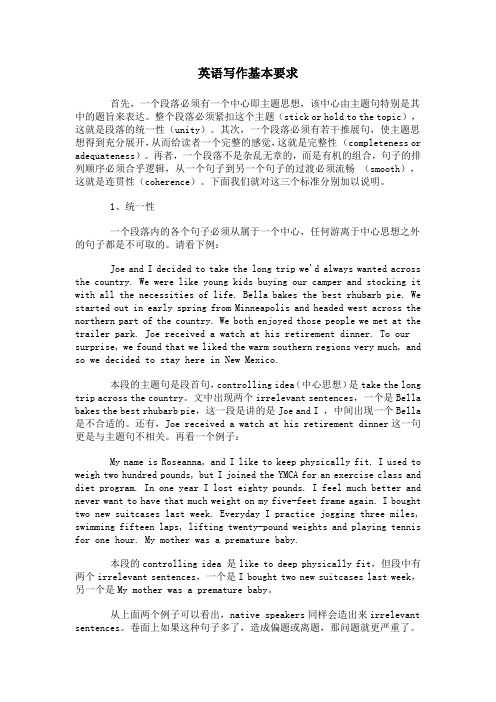
英语写作基本要求首先,一个段落必须有一个中心即主题思想,该中心由主题句特别是其中的题旨来表达。
整个段落必须紧扣这个主题(stick or hold to the topic),这就是段落的统一性(unity)。
其次,一个段落必须有若干推展句,使主题思想得到充分展开,从而给读者一个完整的感觉,这就是完整性(completeness or adequateness)。
再者,一个段落不是杂乱无章的,而是有机的组合,句子的排列顺序必须合乎逻辑,从一个句子到另一个句子的过渡必须流畅(smooth),这就是连贯性(coherence)。
下面我们就对这三个标准分别加以说明。
1、统一性一个段落内的各个句子必须从属于一个中心,任何游离于中心思想之外的句子都是不可取的。
请看下例:Joe and I decided to take the long trip we'd always wanted across the country. We were like young kids buying our camper and stocking it with all the necessities of life. Bella bakes the best rhubarb pie. We started out in early spring from Minneapolis and headed west across the northern part of the country. We both enjoyed those people we met at the trailer park. Joe received a watch at his retirement dinner. To our surprise, we found that we liked the warm southern regions very much, and so we decided to stay here in New Mexico.本段的主题句是段首句,controlling idea(中心思想)是take the long trip across the country。
上海高考英语新题型之概要写作(Summary)
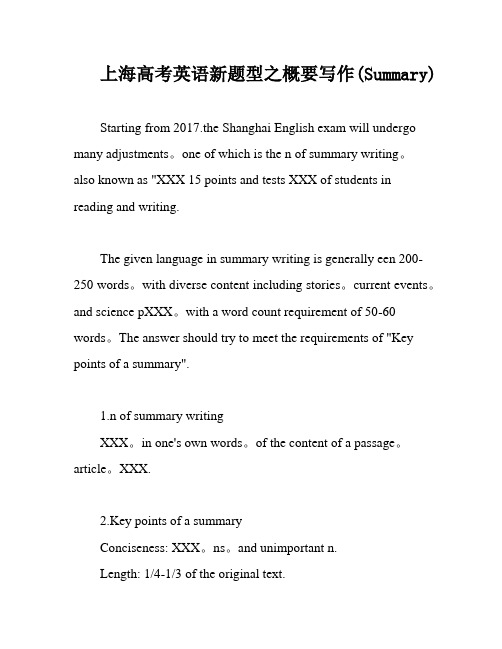
上海高考英语新题型之概要写作(Summary)Starting from 2017.the Shanghai English exam will undergo many adjustments。
one of which is the n of summary writing。
also known as "XXX 15 points and tests XXX of students in reading and writing.The given language in summary writing is generally een 200-250 words。
with diverse content including stories。
current events。
and science pXXX。
with a word count requirement of 50-60 words。
The answer should try to meet the requirements of "Key points of a summary".1.n of summary writingXXX。
in one's own words。
of the content of a passage。
article。
XXX.2.Key points of a summaryConciseness: XXX。
ns。
and unimportant n.Length: 1/4-1/3 of the original text.Completeness: Include all the main and supporting points in a condensed manner。
using your own words.Accuracy: Give the same n and stress to the points as the author does.Coherence: A summary should be a paragraph with XXX to make it flow。
学位英语高频作文

学位英语高频作文1Oh dear friends, let me tell you something about the common types of compositions in the Degree English Exam! Firstly, there's the argumentative essay. In this type, you have to present your clear opinions and provide solid evidence and logical reasoning to support them. Isn't it challenging? For example, when arguing about the benefits of online learning, you might say, "Online learning offers great flexibility, allowing students to study at their own pace. How wonderful is that?"Then, we have the narrative essay. Here, you need to vividly describe an event and express your emotions and feelings. Imagine telling a story about a memorable trip, like, "I still remember that beautiful beach, the gentle waves touching my feet. How amazing the feeling was!" The key is to make the readers feel as if they were there with you.So, you see, these two types of essays in the Degree English Exam each have their unique features and requirements. Are you ready to take on the challenge and do well in the exam? I truly believe you can!2Oh my goodness! Let me tell you about the frequent themes in degree English compositions. One of the common themes is education. Why is this so? Well, in the aspect of education, discussions about learningmethods are always popular. For example, how to study effectively and efficiently? And the topic of educational reform is also frequently mentioned. It makes us think about how to improve the educational system to better cultivate students' abilities.Another important theme is technology. How amazing it is! The influence of new technologies on our lives is a hot topic. Questions like how does artificial intelligence change our work and daily life? And what challenges and opportunities does it bring? These are often explored in compositions.Then there's environmental protection. Isn't it a crucial issue? We need to consider how to protect our planet and achieve sustainable development. The ways to reduce pollution and conserve resources are frequently discussed points.In conclusion, these themes of education, technology, and environmental protection are frequently seen in degree English compositions because they are closely related to our lives and the development of society. So, when preparing for such compositions, we should pay close attention to these areas and think deeply about them.3Oh my goodness! When it comes to writing high-frequency composition for degree English, there are several crucial techniques that can make your writing stand out! Firstly, let's talk about outlining theframework. Before you start writing, you need to have a clear idea of what you want to say. For instance, you could divide your essay into an introduction, several body paragraphs, and a conclusion. How amazing is that?In organizing paragraphs, make sure each one has a distinct topic and smoothly transitions to the next. Use connecting words like "however", "moreover", "therefore" to make your logic crystal clear. Don't you think this is extremely important?Now, about vocabulary! Choose precise and vivid words to enhance the expressiveness of your writing. Instead of using common words, look for more specific and descriptive ones. Isn't that a wonderful way to make your composition more attractive?In conclusion, writing a high-frequency composition for degree English requires careful planning, logical organization, and rich vocabulary. So, keep practicing and improving, and you'll surely achieve excellent results! How exciting it is to master these skills and excel in your studies!4Oh my goodness! When it comes to the scoring criteria of high-frequency composition in degree English, there are several crucial aspects that need our thorough exploration. First and foremost, grammar mistakes can be a major drawback! For instance, if one uses the wrong verb tense or misplaces adjectives and adverbs, points will surely be deducted. Howfrustrating it is when a simple grammatical error ruins the entire piece of writing!Then, the completeness of the content plays a vital role. A composition that lacks a clear beginning, middle and end, or fails to address the key points of the topic, is bound to score poorly. Imagine presenting a piece that rambles aimlessly without a coherent storyline. What a disaster!Language application is also of great significance. The use of rich vocabulary, diverse sentence structures and appropriate idioms and phrases can significantly enhance the quality of the composition. But beware! Using overly complex language that makes the meaning obscure can also lead to a lower score.So, dear friends, let's pay close attention to these aspects when writing degree English compositions. Isn't it essential to strive for excellence and avoid these common pitfalls?5When it comes to degree English high-frequency compositions, there are several remarkable features and writing styles that stand out. Take, for instance, a well-crafted sample. The beginning might go like this: "In the vast landscape of knowledge, the pursuit of academic excellence has always been a beacon guiding us forward. " Such an opening not only grabs the reader's attention but also sets a profound tone for the entire composition.Another aspect is the unique viewpoints presented. For example, "Should we merely follow the beaten path in our academic journey, or dare to forge new trails and challenge conventional wisdom?" This kind of question provokes deep thinking and engages the reader actively.The conclusion could be as powerful as: "In conclusion, the path to achieving academic success is not paved with ease, but with determination, innovation, and a never-ending quest for knowledge. " It neatly wraps up the main ideas and leaves a lasting impression.The reasoning and argumentation throughout the composition are logical and coherent. The use of various examples and references enriches the content and makes the arguments more persuasive. Isn't this the charm of a high-quality degree English composition? How can we not strive to master such skills and excel in our language learning journey?。
高考英语书信写作的“5C”原则例析-精选教育文档

高考英语书信写作的“5C”原则例析自2016年10月浙江省启动新的高考模式以来,英语学科试题中写作部分的第一节应用文连续三次都是考查书信写作:2016年10月首考考查了询问信的写作;2017年6月和2017年11月均考查了邀请信的写作。
一、题型特征解读书信是传递信息、交流情感最常用的方式之一,什么样的英文书信既能让收信人准确地理解写信人的意图,又能得体地传达情感呢?一般来说,需要遵循“5C”原则,即Completeness,Clarity,Conciseness,Coherence和 Courtesy。
第一,格式要完整(Completeness),书信的格式要完整,即包含称呼语(salutation)、正文(body)、结束语(complimentary close)、签名(signature);作者必须把想要反映的客观情况充分地、完整地赋之于文本。
第二,表述要清楚(Clarity),书信的内容一定要写得清楚、准确,其文本意义往往有严格的语境限制,比如确定的时间、地点,确定的对象、范围,确定的行文目的,确定的上下文关系等,使读者的理解能严格按作者铺设的意义轨道运行,让人读后能明确理解写信人的目的或意图。
第三,语言要简洁(Conciseness),力求主旨鲜明、词决意畅,切忌委婉含蓄、词微旨远等。
在人们的工作、生活中,大家都很容易接受简洁、通顺的?Z言,所以写书信时应该避繁就简,用简短的段落、简短的句子来构成一篇简短易懂的书信。
第四,行文要连贯(Coherence),毫无疑问,一篇字面意思连贯且语义连贯的书信才能让收信人读起来爽心悦目,才能更好地达到交际目的,所以,书信的内容除了语法、句法正确外,还要合理组织文章结构,使其内容统一,真正保持书信意义上的连贯。
第五,语气要礼貌(Courtesy),书信应写得得体、有礼貌,同时要朴实,不要使人感到做作、虚伪。
二、高考真题分析假定你是李华,得知外教Mr. Hall 寒假不回国,想邀请他到你家过春节。
高考英语之概要写作
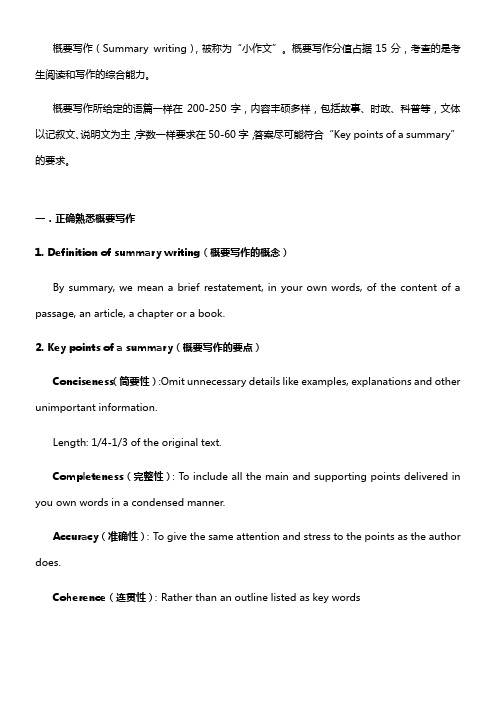
概要写作(Summary writing),被称为“小作文”。
概要写作分值占据15分,考查的是考生阅读和写作的综合能力。
概要写作所给定的语篇一样在200-250字,内容丰硕多样,包括故事、时政、科普等,文体以记叙文、说明文为主,字数一样要求在50-60字,答案尽可能符合“Key points of a summary”的要求。
一.正确熟悉概要写作1. Definition of summary writing(概要写作的概念)By summary, we mean a brief restatement, in your own words, of the content of a passage, an article, a chapter or a book.2. Key points of a summary(概要写作的要点)Conciseness(简要性):Omit unnecessary details like examples, explanations and other unimportant information.Length: 1/4-1/3 of the original text.Completeness(完整性):To include all the main and supporting points delivered in you own words in a condensed manner.Accuracy(准确性):To give the same attention and stress to the points as the author does.Coherence(连贯性):Rather than an outline listed as key wordsand phrases, a summary is a paragraph with necessary transitions and function structures to make it flow.Objectivity(客观性):Do not include your own ideas or emotions on the topic. The summary should reflect the content of the original passage only.3. Steps to write a summary(概要写作的步骤)1)Skim the text to find out the general theme.2)Analyze the text’s structure to divide it into several sections, find out the main idea of each section and write it out briefly with your own words. (one sentence)3)Write down the key supporting points for each main idea without involving minor details.4)Organize the main and related supporting points in a logical order with necessary transitions to achieve coherence.5)Proofread for grammatical, spelling and punctuation mistakes. 4. Beginning of a summary(概要写作的开头)Begin your summary with:*The author’s name*The article’s or chapter’s name*The author’s thesis statement—a general overview(survey) of the article.The Body:First of all, the author describes……He then points out that……In addition, the author talks about……Finally, the author suggests……Some other introductory phrases:*(The author) states in (this article) that…*(The author), in (this article) shows that…*In (this article), (the author) writes that…*As (the author) says in (this article),…*The main idea of (the author’s article) is…*The author believes (holds; maintains; claims; argues; points out; suggests; proposes) that + clause…*The author talks about (explains; describes; reveals; discusses; focuses on) + n.二.记叙文概要写作记叙文体的阅读材料,相较其他文体而言,写概要相对容易。
writing 英语写作
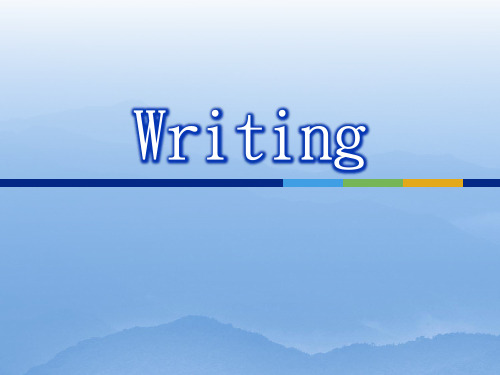
Paragraphs Writing
Features of a paragraphs A central idea (unity)
One paragraphs has one, and only one central idea, which is usually expressed in the first sentence.
hyphens in compound words) should be capitalized, except articles (a, an, the), prepositions (in, for, of, about, on, etc.), coordination conjunctions (and, or, but, nor, and for) and to in infinites.
A pronoun has to agree with its antecedent.
Examples: The teacher is now in her office. The students endeavor to improve their writing skills.
Clear Pronoun Reference
Agreement Between the Subject and the Predicate Verb
The predicate verb of a sentence has to agree with the subject in persons and number.
Agreement Between Pronoun and Antecedent
The beginning (the introduction) The Middle (the body) The end (the conclusion)
英语专业写作基础教程1-6单元笔记
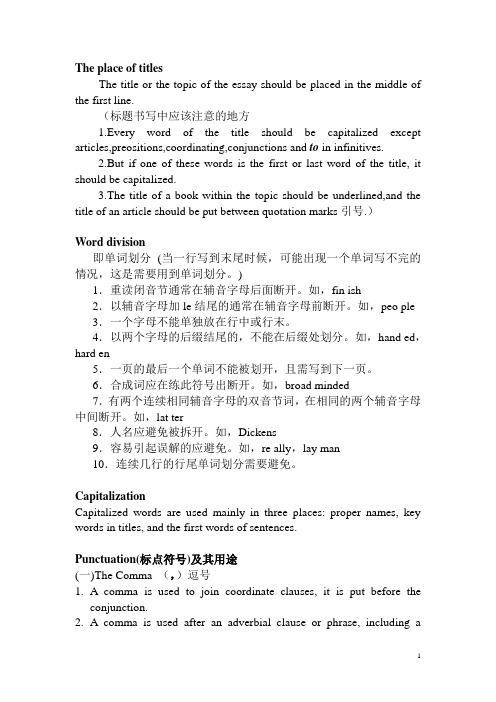
The place of titlesThe title or the topic of the essay should be placed in the middle of the first line.(标题书写中应该注意的地方1.Every word of the title should be capitalized except articles,preositions,coordinating,conjunctions and to in infinitives.2.But if one of these words is the first or last word of the title, it should be capitalized.3.The title of a book within the topic should be underlined,and the title of an article should be put between quotation marks引号.)Word division即单词划分(当一行写到末尾时候,可能出现一个单词写不完的情况,这是需要用到单词划分。
)1.重读闭音节通常在辅音字母后面断开。
如,fin ish2.以辅音字母加le结尾的通常在辅音字母前断开。
如,peo ple 3.一个字母不能单独放在行中或行末。
4.以两个字母的后缀结尾的,不能在后缀处划分。
如,hand ed,hard en5.一页的最后一个单词不能被划开,且需写到下一页。
6.合成词应在练此符号出断开。
如,broad minded7.有两个连续相同辅音字母的双音节词,在相同的两个辅音字母中间断开。
如,lat ter8.人名应避免被拆开。
如,Dickens9.容易引起误解的应避免。
如,re ally,lay man10.连续几行的行尾单词划分需要避免。
CapitalizationCapitalized words are used mainly in three places: proper names, key words in titles, and the first words of sentences.Punctuation(标点符号)及其用途(一)The Comma (,)逗号1.A comma is used to join coordinate clauses, it is put before theconjunction.2.A comma is used after an adverbial clause or phrase, including aprepositional and a participial phrase before the subject, or inserted in the middle of the sentence.mas are used to separate a series of words or phrases with thesame function in the sentence:4.Nonrestrictive clauses and phrases are set off by commasmas set off parenthetical elements6.In dates, a comma is used to separate the day and the year if the orderis month—day—year; no comma need be used if the order is day—month—year.7.With numbers of 1 000 or over, commas or little blank spaces may beused to separate digits by thousands. Form right to left, a commas is placed after every three numerals.(二)The Period (. )句号1.The period is used at the end of a declarative sentence, a mildlyimperative sentence, and an indirect question.2.The period is used with most abbreviations.3.Three spaced period make the ellipsis mark, which indicates theomission of one or more words within a quoted passage.(三)The Semicolon (;)分号1.The semicolon is used between two coordinate clauses which are notlinked by a conjunction.2.Conjunctive adverbs like therefore, however, nonetheless, hence,otherwise, besides, moreover, etc., should not be used as conjunctions to link two coordinate clauses, before them there should be a semicolon, not a comma.3.The semicolon is used with conjunctions when the clauses containinternal punctuation.4.The semicolon is used to separate a series of items with internalcommas.5.A semicolon may be used to join clauses with words omitted, and theomission is sometimes indicated by a comma.(四)The Colon (:)冒号1.The colon is used to introduce a quotation or a statement.2.The colon is used to introduce an examination, a summary, or anappositive.3.The colon is used between the hour and the minute to show the time,to record the scores of games, to end the salutation of a business letter and the introductory remark of a spealer to the chairman and audience.(五)The Question Mark (?)问号1.The question mark is used after a direct question.2.The question mark is used after a statement turned into a question.3.A question mark put between parentheses indicates the writer’suncertainty about the correctness of the preceding word, figure or date.(六)The Exclamation Mark (!)叹号1.The exclamation mark is used after an exclamatory sentence, or anemphatic interjection, or a phrase expressing strong emotion..2.Sometimes the exclamation mark is used after a slogan.(七)Quotation Marks(…)引号1.Double quotation marks are used to enclose direct quotations indialogue or from books or articles.2.Single quotation marks are used to enclose a quotation within aquotation.3.Indirect quotations are not enclosed by quotation marks.4.Quotation marks are used for titles of articles, essays, short stories,short poems, songs, etc., and for headings of chapters or subdivisions of books. Titles of books, newspapers and magazines are generally underlined or italicized.5.Words with special meaning are sometimes put between quotationmarks,(八)Parentheses/Brackets (())圆括号1.Parentheses are used to set off parenthetical, supplementary, orillustrative words.2.Parentheses enclose figures or letters used for enumeration.(九)Square Brackets(【】)方括号1. Square Bracketsare used to indicate corrections or explanations in quoted matter made by the writer who is quoting .2. Square Brackets are used instead of parentheses within parentheses.(十)The Dash (—)破折号1.The dash indicates a break in thought or a change in tone, or aspeaker’s confusion or he sitation.2.The dash indicates an unfinished or interrupted statement.3.A pair of dashes set off a parenthetical element.4.The dash is sometimes used to introduce a summarizing clause after aseries of nouns.5.The dash is sometimes used just like quotation marks in a dialogue.6.The dash may be used to introduce subheadings and authors afterquotations.(十一)The Slash (/ )间隔号1.The slash indicates alternatives, representing the word or or and\or2.The slash is used to separate lines in short quotations of poetry beingquoted in running text.3.When fractions are written in a sentence, a slash is used to separate thenumerator from the denominator.4.Sometimes the slash means “per.”四种句型及其用途Comma逗号——declarative sentence(陈述句):makes an assignment or statementQuestion mark问号——direction question sentence(疑问句):ask a questionExclamation mark叹号——Imperation sentence(祈使句):express a command or a request Exclamatory sentence(感叹句):express a strong feeling or emotionUnderlining and italics1.Titles of books, periodicals, newspaper, plays, movies, operas, andlong poems are underlined or italicized.2.Foreign words are often underlined or italicized.3.Words and letters referred to as such are underlined or italicized.s of ships, aircraft and tragic sinking of the titanic.5.Sometimes underlining or italicizing indicates emphasis.【Words】一、Type of wordsCommon wordsFormal and technical words:(political,legal,scientific,technical,bussiness,literary)Nonstandard words:(slang,jargon,dialectal and obsolete)二、Choice of wordse common or informal words for general purposes; use formal ornonstandard when only on special occasions or for special purposes. e specific and concrete words when giving details; use general orabstract words when making summaries.e idiomatic expressions and words in acceptable collocations; avoidcombinations and that are unidiomatic.4.When there are synonyms, choose the word that expresses themeaning most exactly and that suits the content and style.三、SynonymsThe english language is very rich in synonyms. This is partly due to the fact that english has over the centuries borrowed or absorbed tens of thousands of words from other languages, mainly Greek, Latin and French. Word of anglo-saxon origin are generally colloquial or informal, and they form a great part of the vocabulary that people use daily. Many of the words of greek, latin, and french origin are formal, learned or “big”; and are mainly used in formal writing or speech.四、Some good dictionaries1.Longman dictionary of contemporary english2.Oxford advanced learner’s dictionary of current english.3.Webster’s new word dictionary.4.Collins cobuild english language dictionary.【Sentences】一、Composed sentences 构建句子:①complete structure②begin with a capital letter③full stop, or a question mark, or an exclamation mark④a single complete idea二、Requirement of correct sentences及其对应错误pleteness in structure—fragment in structure2.the right subject—the wrong subject3.agreement between the subject and the predicate verb—disagreement between the subject and the predicate verb 4.agreement between pronoun and antecedent—disagreement between pronoun and antecedent5.clear pronoun reference—unclear pronoun reference6.ending sentences with full stops—ending sentences with no full stops7.joining clauses with conjuctions—joining clauses with no or wrong conjuctions8.a main claus in a complex sentence—no main claus in a complex sentence9.proper use of comparisons—improper use of comparisons10. correct use of the tenses—incorrect use of the tenses四、Quality of effective sentencesEffective sentences have the following quality:Unity(完整性)Coherence(连贯性)Conciseness(简明扼要性)Emphasis(强调)( ways of emphasis:placing, climactic sequence, subordination,the use of verbs in the active voice,balanced sentences平行结构,periodic sentences圆周句,negative/positive sentences,rhetorical question,loose sentences松散句)Variety(表达多样性)五、The difference between subordination and coordinationCoordination is tipically realized by coordinators which join units at the same level while subodination is realized by subordinators which distinguish the superodinate claus and the inferior clause.【Paragraph】一、Ways of developing a paragraphThere are many possible ways to develop a paragraph.(1)development by time(2)development by process(3)development by space(4)development by examples or generalization(5)development by comparison and contrast:(the difference between comparison and contrast :When we compare one thing with another, we show the similarities;when we contrast one thing with another, we show dissimilarities.) (6)development by cause and effect(7)development by classification(8)development by definition(9)development by combination of methods二、The steps of developing a paragraphFirst, think of the topic or theme or main idea,And express it in a complete sentence(topic sentence).Then think of the details or examples or facts that may be used to support or explain the main idea.Work out the outline and arrange them in logical order.三、Features of a paragraphA effective paragraph must have a control idea, and this central idea may be expressed either explicitly in a topic sentence.【Summray】一、Definition (定义)A sumary is the gist or main theme of a piece of a piece of writing expressed in as few words as possible .it should be clear ,brief,and complete,with all the essential points included.二、Uses(用途)①summary writing enables people to get more out of their reading.②summary writing is also a very good exercise to teach us to express thoughts clearly,concisely and effectively.③summary writing has great practical value on grasping quikly and accurately what is read or heard.三、Procedure(步骤)⑴ reading⑵ writing⑶ revision四、Requirements(要求)A.we should be sure of the word limit required .B.we should use our own words to write a summary.C.we should convey the message fully and clearly.D. We should write in the logical order of the original passage.E. Compression (压缩)五、Ways(方法)A. Ommit the details 删除细节B. Reduce the examples 削减例子C. Refuse repeatness 避免重复D. Simplify the decription 简化描述E. Comprise wordy 全面用词F. Generable words 多用泛词e the shortest transitions 最简洁的过渡词H.inderect speech 间接引语【Composition 】一、Steps in writing a composition1.planning a composition( ① putting down all the relevant facts② thinking of a proper theme and deciding on our purpose③ re-examing our list of details and outlining )2.writing the fist draft3.revising the first draft4.making the final copy二、Parts in composition1. the beginning ——introduction(Ways of start a composition :start with …① relevant background material② the time and place of the event to be described③ a quotation④ a question⑤ a statement⑥ a figures or statistics⑦ a definition )2. the middle ——body3.the end ——conclusion三、Types of writing1.narration 记叙体2.exposition 说明文四、Criteria of a good composition (一篇好文章的标准)A good composition have something interesting and/or important,and if possible, something new , to say and that this “something”is expressed clearly, accurately, and appropriately. And we must decide on the purpose and audience of our writing and try to adapt the style and language to suit our purpose and audience.【Outline】一、Types of outline1. sentence outline: made up of sentences2.topic outline:consists of nouns and their modifiers, or their equivalents( =gerund phrases or infinitive phrases )二、Rules for writing outlinesIf we examine closely the two outline above, we may see that they follow these rules:(1)if there is a major point marked “Ⅰ”, there must be at least another marked “Ⅱ”;if there is an “a”, there must be a “b”, and so on.(2)a topic outline is written in noun phrase, and a sentence outline, in sentences. Sentences and phrase are not used together in the same outline. (3)parallel structure are used for the headings of the same rank. Subheads of like rank are of equal importance and are related to the heading and arranged in logical order.(4)the thesis is a complete declarative sentence, usually in the affirmative. It is not a question, a phrase, or a dependent clause, but one sentence which expresses our controlling idea.。
自考商务英语写作名词解释题
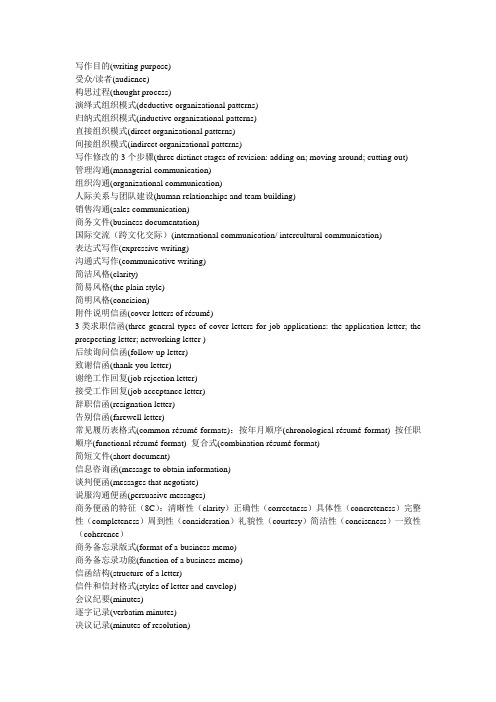
写作目的(writing purpose)受众/读者(audience)构思过程(thought process)演绎式组织模式(deductive organizational patterns)归纳式组织模式(inductive organizational patterns)直接组织模式(direct organizational patterns)间接组织模式(indirect organizational patterns)写作修改的3个步骤(three distinct stages of revision: adding on; moving around; cutting out)管理沟通(managerial communication)组织沟通(organizational communication)人际关系与团队建设(human relationships and team building)销售沟通(sales communication)商务文件(business documentation)国际交流(跨文化交际)(international communication/ intercultural communication)表达式写作(expressive writing)沟通式写作(communicative writing)简洁风格(clarity)简易风格(the plain style)简明风格(concision)附件说明信函(cover letters of résumé)3类求职信函(three general types of cover letters for job applications: the application letter; the prospecting letter; networking letter )后续询问信函(follow-up letter)致谢信函(thank-you letter)谢绝工作回复(job rejection letter)接受工作回复(job acceptance letter)辞职信函(resignation letter)告别信函(farewell letter)常见履历表格式(common résumé formats):按年月顺序(chronological résumé format) 按任职顺序(functional résumé format) 复合式(combination résumé format)简短文件(short document)信息咨询函(message to obtain information)谈判便函(messages that negotiate)说服沟通便函(persuasive messages)商务便函的特征(8C):清晰性(clarity)正确性(correctness)具体性(concreteness)完整性(completeness)周到性(consideration)礼貌性(courtesy)简洁性(conciseness)一致性(coherence)商务备忘录版式(format of a business memo)商务备忘录功能(function of a business memo)信函结构(structure of a letter)信件和信封格式(styles of letter and envelop)会议纪要(minutes)逐字记录(verbatim minutes)决议记录(minutes of resolution)陈述记录(minutes of narration)记录内容版式(minutes’ content format)会议议程(meeting agenda)会议筹划(meeting preparations)会议程序(3个环节)(meeting process: planning & preparing, conducting, and following-up) 会议后续工作(follow-up activities)后续文案职责(accountability of follow-ups)书面发言写作策略(writing strategies for business presentation)书面发言的材料组织(wring organization for business presentation)书面发言用语(language used in a presentation)书面发言避讳用语(language avoided in a presentation)人际沟通的功能(functions of interpersonal communication)人际沟通的目的(purpose of interpersonal communication)人际沟通的4个阶段(four general stages in interpersonal communication)团队的特征(group characteristics)团队的角色(group roles)团队影响力(group influence)沟通结构(communication structures)企业前景(vision)企业使命(mission)企业价值观(corporate values)企业目标(goal)战略计划(strategies)政策与流程(policies and procedures)业务流程的构成要素(15个)(content of procedures)业务流程的版式及内容(format of a procedure)商务文件的层次结构(3个)(tiers of documentation)ISO 9000质量体系(ISO 9000 Quality System )商务蓝皮书(blueprint)商务计划书(business plan)战略性计划书(strategic plan)战术性计划书(tactical plan)操作性计划书(operational plan)操作性管理(operational control)战术性管理(tactical control)战略性管理(strategic control)商务背景(business background)市场计划(marketing plan)财务预测(financial projections)行动计划(action plans)商务提案(business proposal)内部提案(internal proposal)外部提案(external proposal)招标提案(solicited proposal)非招标提案(unsolicited proposal)提案写作的简单模式(simple form for proposal writing)提案写作的复杂模式(detailed form for proposal writing)外部提案的结构要素(6个)(elements of the external proposal: introduction; problem identified and defined; objective & goal set; solutions proposed; implementation & measuring; costs and timeframe estimated)内部提案模式的内容版式(content format of internal proposal)征集提案(Request for Proposal, RFP)征集启示的基本要素(basic components of a RFP)提案评估(proposal evaluation)议程报告(agenda)行程安排(itinerary)费用支出报告(expense reports)项目进程报告(progress report)人事评估报告(personnel evaluation)第一手资料来源(primary sources)第二手资料来源(secondary sources)引证信息(documenting information)解析数据(interpreting data)常规商务报告(routine reports)任务报告(task reports)条目清单功能(itemized lists)图表辅助功能(graphic aids)标题的功能(headings)协议的本质(essence of a deal)合同的修订(contractual modifications)违约与补偿(breach of contract and remedy)律师费用条款(attorneys fees clause)合同免责(escape from contract)第三方签字(third party signature)合同追加条款(contract rider)合同授权(authorization)商务谈判(contract negotiation)合同起草(contract drafting)合同实施(execution)合同终止(closeout)合同(contract)合同有效性(validity of contracts)要约(offer) 接受(acceptance)法定权力(capacity)Sales contracts 买卖合同Contracts for supply of power ,water,gas or heat 供应电、水、气、热力合同Contracts for loan of money 借款合同Leasing contracts 租赁合同Financial leasing contracts 承揽合同Contracts for construction projects建设工程合同Carriage contracts运输合同Technology contracts 技术合同Safekeeping contracts 保管合同Warehousing contracts 仓库合同Agency appointment contracts 委托合同Trading-trust contracts行纪合同Brokerage contracts居间合同。
Completeness

Writing assignment
The following sentence is a given topic sentence. Please develop it into a complete paragraph . Pay attention to the writing technique of unity and completeness we have discussed.
Although advertisement can be a service to people, it also h criteria of completeness a complete framework. Namely, in a paragraph, there is topic sentence, supporting sentences and a concluding sentence. it does not mean a lot of words, rather it means that you have had an adequate discussion on the topic. The readers feel that they are convinced or impressed after reading your paragraph even if they may have different ideas.
What does completeness mean?
concept :Completeness in a paragraph means that the topic is adequately developed methods: the topic can be developed by details, explanation, evidence, examples, quotation, or figures to expand the topic into a whole one, but the degree of development depends on the purpose and the content of the paragraph.
英语外贸函电 (第三)

大连理工大学出版社
Part 1
The Basic Requirements of Business English Letter Writing
3. Clearness/Clarity (清楚)
Make sure that your letter is so clear that it cannot be misunderstood. A point that is ambiguous in a letter
大连理工大学出版社
Part 1
The Basic Requirements of Business English Letter Writing
5. Courtesy (客气)
Courtesy is not mere politeness. It is like a favorable introduction card. The courteous writer should be
大连理工大学出版社
Part 1
The Basic Requirements of Business English Letter Writing
1. Completeness (完整)
A business communication should include all the necessary information. It is essential to check the message
大连理工大学出版社
Part 1
The Basic Requirements of Business English Letter Writing
The purposes of communication are to obtain complete understanding between the parties involved, and to elicit the responses required. Generally speaking, the functions of a business letter are to ask for or to convey business information, to make or to accept an offer, and to deal with matters concerning various businesses. Business letter writing does not differ from any other form of creative writing. Good English is one of the
写作业过程的文章英语
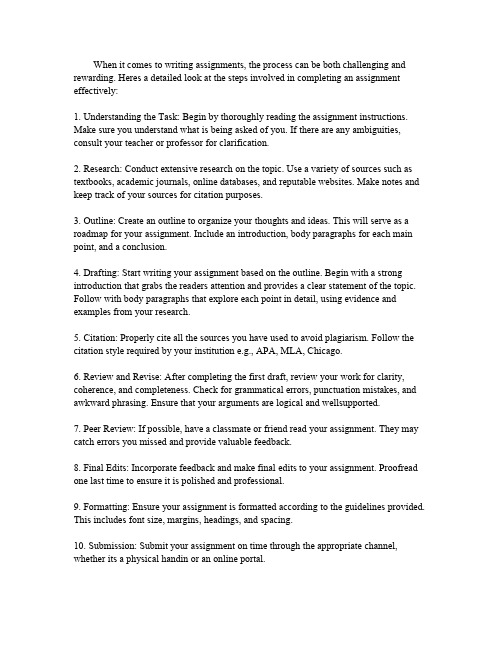
When it comes to writing assignments,the process can be both challenging and rewarding.Heres a detailed look at the steps involved in completing an assignment effectively:1.Understanding the Task:Begin by thoroughly reading the assignment instructions. Make sure you understand what is being asked of you.If there are any ambiguities, consult your teacher or professor for clarification.2.Research:Conduct extensive research on the e a variety of sources such as textbooks,academic journals,online databases,and reputable websites.Make notes and keep track of your sources for citation purposes.3.Outline:Create an outline to organize your thoughts and ideas.This will serve as a roadmap for your assignment.Include an introduction,body paragraphs for each main point,and a conclusion.4.Drafting:Start writing your assignment based on the outline.Begin with a strong introduction that grabs the readers attention and provides a clear statement of the topic. Follow with body paragraphs that explore each point in detail,using evidence and examples from your research.5.Citation:Properly cite all the sources you have used to avoid plagiarism.Follow the citation style required by your institution e.g.,APA,MLA,Chicago.6.Review and Revise:After completing the first draft,review your work for clarity, coherence,and completeness.Check for grammatical errors,punctuation mistakes,and awkward phrasing.Ensure that your arguments are logical and wellsupported.7.Peer Review:If possible,have a classmate or friend read your assignment.They may catch errors you missed and provide valuable feedback.8.Final Edits:Incorporate feedback and make final edits to your assignment.Proofread one last time to ensure it is polished and professional.9.Formatting:Ensure your assignment is formatted according to the guidelines provided. This includes font size,margins,headings,and spacing.10.Submission:Submit your assignment on time through the appropriate channel, whether its a physical handin or an online portal.Remember,writing an assignment is not just about completing the task but also about demonstrating your understanding of the subject matter and your ability to communicate effectively.Take your time,stay organized,and dont be afraid to ask for help if you need it.。
大学英语精读文本1-6册

ELEMENTS OF THE RESEARCH PAPER
The standard research report, regardless of the field or the intended reader, contains four major sections. These sections may be broken down into a variety of subsections, Байду номын сангаасnd they may be arranged in a variety of ways, but they regularly make up the core of the report.
A frequent subsection of this problem section is a review of past research on the topic being investigated. This would consist of summaries of the contributions of previous researcher to the question under consideration with some assessment of the value of these contributions. This subsection has rhetorical usefulness in that it enhances the credibility of the researcher by indicating that the data presented is based on a thorough knowledge of what has been done in the field and, possibly, grows out of some investigative tradition.
商务英语写作的7C原则PPT课件

提示: 违背了“简洁”(Conciseness)原则
Case Studies (案例分析)
Because our book is full, so we cannot entertain any more orders.
由于我方订货已满,恕不能接受更多的 订单。
提示: 违背了“准确”(Correctness)原则
微课名称:商务英语写作中的7C原则 所属课程:高级商务英语写作 主讲教师: PPT版权:浙江广播电视大学外国语学院 李更春
在商务信函的写作中,我们应遵循哪些原则呢?
正式 (formal)
迂回 (winded)
清晰 (clear)
详尽
具体
(detailed) ( concrete)
笼统 (general)
Completeness (完整)
Business writing should also be complete in terms of format and information.
As to format, a business letter should include a letterhead, date, inside address, salutation, subject, body of letter, complimentary close and signature.
Conciseness (简洁)
例句
We have begun to export our machines to the foreign countries. (我 们已经开始向国外出口机器了)
We have begun to export our machines.
基本无害的计量经济学 英文版

基本无害的计量经济学英文版以下为您生成 20 个关于“写基本无害的计量经济学”(Writing Essentially harmless econometrics)的相关英语释义、短语、单词、用法和双语例句:1. **单词**:econometrics (英语释义:The branch of economics that uses statistical methods to analyze economic data. )- 用法:“Econometrics is a complex subject.”(计量经济学是一门复杂的学科。
)2. **单词**:harmless (英语释义:Not causing harm or damage. )- 用法:“The snake is harmless.”(这条蛇无害。
)3. **单词**:essentially (英语释义:In the most important or fundamental way. )- 用法:“Essentially, this is a difficult problem.”(从根本上说,这是个难题。
)4. **单词**:writing (英语释义:The activity of putting words on paper or a computer screen. )- 用法:“I enjoy writing stories.”(我喜欢写故事。
)5. **短语**:statistical method (英语释义:A way of dealing with and analyzing data using statistics. )- 用法:“We used statistical methods to analyze the data.”(我们使用统计方法来分析数据。
)6. **短语**:economic data (英语释义:Information related to the economy. )- 用法:“The research is based on extensive economic data.”(这项研究基于大量的经济数据。
英语写作业顺序
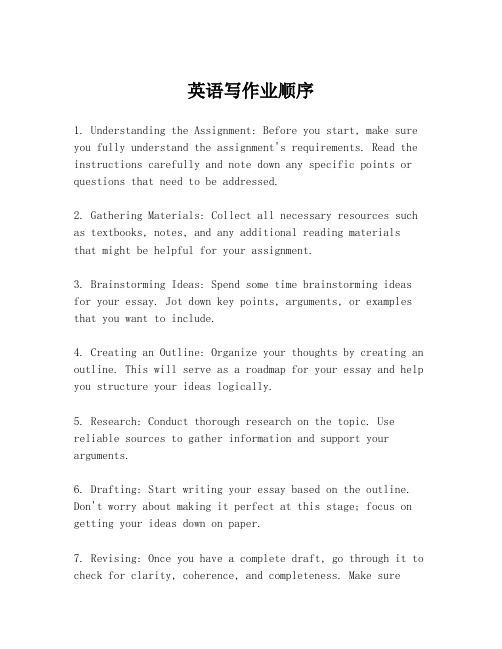
英语写作业顺序1. Understanding the Assignment: Before you start, make sure you fully understand the assignment's requirements. Read the instructions carefully and note down any specific points or questions that need to be addressed.2. Gathering Materials: Collect all necessary resources such as textbooks, notes, and any additional reading materialsthat might be helpful for your assignment.3. Brainstorming Ideas: Spend some time brainstorming ideas for your essay. Jot down key points, arguments, or examples that you want to include.4. Creating an Outline: Organize your thoughts by creating an outline. This will serve as a roadmap for your essay and help you structure your ideas logically.5. Research: Conduct thorough research on the topic. Use reliable sources to gather information and support your arguments.6. Drafting: Start writing your essay based on the outline. Don't worry about making it perfect at this stage; focus on getting your ideas down on paper.7. Revising: Once you have a complete draft, go through it to check for clarity, coherence, and completeness. Make sureyour arguments are well-supported and your essay flows smoothly.8. Editing for Grammar and Style: After revising the content, focus on grammar, punctuation, and style. Ensure that your sentences are grammatically correct and that your writing style is consistent.9. Proofreading: The final step is proofreading. Read through your essay carefully to catch any typos, spelling mistakes, or formatting errors.10. Seeking Feedback: If possible, ask a peer or a tutor to review your work. They can provide valuable feedback and help you improve your essay further.11. Finalizing: Incorporate any feedback you've received and make the necessary changes. Then, print or save your final version of the essay.12. Submitting: Finally, submit your assignment according to the guidelines provided by your teacher or institution. Make sure to follow any specific submission instructions to avoid any issues.。
Memowriting备忘录英语写作
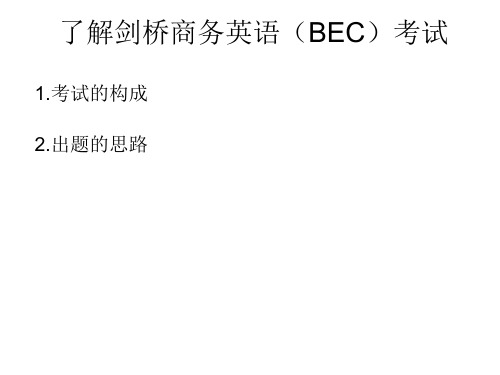
• • •
• •
• • • •
Kimball, Walls, and Morganstern
Memorandum
DATE: Jan. 4, 2009 TO: All Staff FM: Simon Miller (Technical Department) SUBJECT: Upgrading the Computer System
考试目的
BEC考试的成功之处让学生真正具备商业 交际能力,真正是用英语在工作(以英语为 工具),真正在为一个企业出谋划策。 真正的认可度最重来源于企业的用人需 求,从这一点来说,这是其他的很多考试 不能与之相比的 。
出题思路
测试应试者Байду номын сангаас: 英语水平(词汇,语法) 商务知识 (经济运行与企业管理 如ordering goods, performance appraisal, public relations) 逻辑思维能力(比较、分析、综合、抽 象、概括、判断、推理的能力)
了解剑桥商务英语(BEC)考试
1.考试的构成 2.出题的思路
考试的构成
阅读理解(60分钟) 商务写作(45分钟) 听力测试(40分钟) 口语测试(12/14/16分钟)
写作文本
• 1. note writing 2. E-mail writing 3. memo writing 4. letter writing 5. report writing 6. proposal writing 9. Data analysis
Criteria for Effective Business Communication
• Clearness refers to the fact that the meaning the reader gets is just the meaning the writer intended, the reader doesn’t have to guess. It eliminates the possibilities of misunderstanding so that economy and work efficiency could be enhanced as no further exchange of messages for explanation will be needed. Clearness is the ultimate goal of business writing. If your reader doesn’t understand you, the other criteria such as conciseness, correctness, completeness and building good will not help. Conciseness means getting to the point and making the message compact by eliminating the wordiness, awkward business jargons and irrelevant information. Concise message saves time and expense for both writer and reader by helping to make the message clearer, but it shouldn’t be achieved with the sacrifice of completeness and building goodwill. Completeness means covering all the necessary information, answering all questions and requirements put forward by the reader. The reader has enough information to evaluate the message and act on it. Correctness means giving accurate facts and figures and avoiding the mistakes in relation to spelling, grammar and even punctuation. Great importance should be attached to correctness in business communication as lots of information regarding dates, specifications, prices, quantities, etc. will be covered and a minor mistake may lead to making no profit or even losing out. Building goodwill means presenting a positive image of the writer and the organization that he or she represents by offering sincere consideration to the reader’s needs and feelings. Messages with goodwill smooth the challenge of business and help to cement a good relationship between the writer and the reader.
英文商务信函写作的基本知识

3. 信函编号( Reference number )
给信函编号是为了便于往来书信的存挡和查阅, 一般采用Your Ref. (你方编号)或 Our Ref.(我 方编号)。信函编号通常放在日期的上方或与日 期平齐靠左的位置,打上如下字样:
Your Ref. :
Our Ref.:
4. 信内地址(Inside address )
5. 礼貌(Courtesy ) 在商务信函的写作过程中,及时是礼貌之首。 此外,应避免使用可能激怒、伤害对方的言辞或 语气,语调上要尽可能站在客户的立场上做到互 惠互利。
6. 体谅(Consideration ) 发信人应尽可能从收信人的立场来考虑问题,在 分析对方会如何理解信息的基础上,提供其所需 要的信息。
要写就一封成功的商务信函,需要起草人具备以下 条件:
(1)精通英语( Good command of English ) (2)通晓外贸理论和实务( Knowledge of
business theory and practice ) (3)通晓术语( Knowledge of technical terms ) (4)通晓人的心理( Knowledge of psychology ) (5)熟悉推销艺术( Skills in salesmanship )
your letter (inquiry, telex, email, fax etc.) of…
In reply to
(3)回复来信中的有关问题
With reference to
In reference to Referring to
your letter (inquiry, telex, e-mail, fax etc.) of…
- 1、下载文档前请自行甄别文档内容的完整性,平台不提供额外的编辑、内容补充、找答案等附加服务。
- 2、"仅部分预览"的文档,不可在线预览部分如存在完整性等问题,可反馈申请退款(可完整预览的文档不适用该条件!)。
- 3、如文档侵犯您的权益,请联系客服反馈,我们会尽快为您处理(人工客服工作时间:9:00-18:30)。
Paragraph Completeness
Independent enrollment is unprecedented in the educational history of China. It is exciting news for everyone. We are witnessing a delightful change taking place on the basis of the enrollment system: from a single nationwide entrance examination to self-designated interviews. We are aware that the vague concept of independent enrollment makes people doubt the fairness of the new system.
Paragraph Completeness
What do you think of the paragraph? What’s the topic sentence? Are their enough details to develop the topic sentence?
Paragraph Completeness
Obviously the second paragraph is more fully developed than the first, which contains nothing but a bare statement of the idea. The second paragraph brings the idea to life by spelling out the details about Richard’s talent, intelligence and kindness.
Paragraph completeness
As far as I concerned, CAI is such convenient that it gives us the information or communication from long distance and broadens our horizon of the knowledge. I am in great favor of the computer assisted instruction. It is the age of information explosion, and also the IT time, the CAI gives us opportunities to contract with the society as early as possible. What’s more, it gives us chances to show our standpoints and receive the reflection easily.
Now look at the following example.
Paragraph Completeness
I admire my friend Richard because he is so talented, intelligent, and kind (Topic sentence).
Paragraph Completeness
The above example also leaves much to be desired: exactly what is the goal of our education reform? What is so good about CAI?
Paragraph Completeness
Exercises
The above example features some big talk, like revolutionized the traditional, boring way of delivering classes, our teaching is also supposed to be keeping pace with the fast-growing world, opens the mind of both teachers and students, but the reader expects more substance.
Paragraph completeness
Not every paragraph need be very long, of course. The length of a paragraph is determined by its topic sentence. You have to decide how much material you need to develop the idea.
Paragraph completeness
But remember, a complete paragraph does not mean a paragraph with a lot of sentences but lacking substance. This is a common problem among Chinese students.
Paragraph completeness
Some ideas require more development than others, but you should be wary of a paragraph of 2 or 3 sentences only. You should use as many facts, details, examples, or reasons as you need to develop your point, but no more.
Paragraph Completeness
I admire my friend Richard because he is so talented, intelligent, and kind. He is also very intelligent and can understand complex problems very quickly. Above all, he is very kind to others. I admire my friend for all these reasons.
Paragraph Completeness
The point is that we should not only focus on the potential problems, but on the potential strengths. The previous uniform examination has become a fixed pattern and everyone can follow relevant rules and be admitted to a university. It is unhealthy for the students’ future development and may make the students exam machines.
Paragraph Completeness
Although he is so intelligent and gifted, he is not standoffish or boastful. Indeed, Richard is one of the kindest person I know. If anyone has a problem, they know they can go to him for help. If anyone is ill, he is always to first to visit him; and if anyone is sad he is always very quick to cheer him up. What are these details for?
Paragraph Completeness
If a person has such wonderful qualities, I think you will agree that it is impossible not to admire him.
Paragraph completeness
Paragraph Completeness
Not only can he play most sports well, he is also a good musician and actor. He has always been the best student in his class, and in the recent pre-university exams, he was placed third in the entire country. Which part of the topic sentence do these details support?
This means using enough facts, details, examples, quotations of authorities, or reasons to support the topic sentence. Take a look at the following example.
Paragraph Development
Paragraph Completeness
Paragraph Completeness
A paragraph must be complete. Every paragraph must be adequately developed.
